On to How to Store your Costumes
On this page I'll discuss design concepts, such as the color, shape, texture, use of space and cultural context of your costume designs. I'll show some sources for inspiration that may help you to come up with your own designs. Also, I'll show examples of sketches I've made for my designs, and ways to make your own sketches with or without a great deal of artistic talent.
~Design Concepts
.....~Color
.....~Shape
.....~Texture
.....~Positive and Negative Space
.....~Cultural Context
~Inspiration
~Sketching your Design
The appearance of all things can be broken down into several characteristics: color, shape, texture, positive and negative space, and cultural context. I'll discuss and explain each of these aspects.
There are three types of color combinations: complementary, analogous, and triad, and they are defined by the relative locations of the colors on the wheel. (This may be a lot to absorb, but it's pretty cool, so stick with me.) Blue with orange (or copper) is complementary, because blue and orange are on opposite sides of the wheel. Blue and Green would be analogous colors, as would be any two consecutive pie pieces or two consecutive circles. Blue, red and yellow together would be a triad, since they are exact thirds of the wheel away from each other. Even though all three of the costumes in the next image have the exact same spiral patterns on them, the colors used change the appearance of the patterns. A fourth option not illustrated is multiple shades of a single color - or a monochromatic costume, such as shades of blue, or shades of grey.
You can use a color wheel to come up with ideas for color combinations that might never have occurred to you before. Fuchsia and coral? Why not. Also, take into consideration what colors your body is made up of. Have blue eyes? Wear colors that enhance your shade of blue. Have dark skin? Try bright colors. Have pale skin? Try deep jewel tones. This is not to say that you are limited to any particular palette. You know better than anyone what colors you look best in. I look best in fall colors, and no matter how much I think fuchsia looks great on others, for me it's just not meant to be.
When it comes to shape, the mechanical engineer in me says let form follow function. Think about the way you dance. Do you do a lot of sharp and small tick-tocks or isolations? Then maybe a more clingy costume (trumpet skirt, Melodia pants) would let those movements be seen. Do you spin a lot and make broader hip movements? Then maybe a circle skirt and bedlah with long fringe will accent those movements better. I often pick the style of costume I'm going to wear based on the song and the movements it inspires.
There is also the aesthetic issue of the shape of your body and how you'd like to enhance it. There are parts of our appearance we love, and parts we wish were less noticeable. Many people will tell you that there is no single true ideal - but they're actually incorrect. (Scandalous! But before you blog in outrage, read on...) There is a thing of beauty found in every corner of the universe called the Golden Ratio. Much like the number pi, this number is a very long decimal that goes on forever. But it's basically 1.62. I'll explain. Take a picture of yourself. If the width of your face is 1, the distance from the bottom of your chin to the top of your head should be 1.62. The elements of your height above and below the waist are determined by the golden ratio, as illustrated on Leonardo DaVinci's work below. The same thing is true about the distance between just about all of your facial features and body parts, as well as the spirals of galaxies and seashells. I'm not joking. It's true. Subconsciously we see it and we know it's beautiful. It's also a sign of health and fertility. So if you want to make yourself look more attractive, you could calculate what (if any) parts of you are slightly off of the golden ratio - like how a wider hair cut can make a longer face look better. However, odds are that most of you is perfectly gorgeous already. ;)
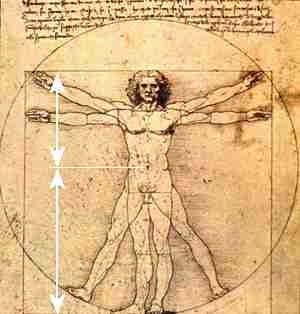
There is another ratio you can focus on - your hip-to-waist ratio. You want your bust and hips to be about the same circumference, or perhaps have the hips be a little bigger, and for women you want your waist to be 70% the size of your hips (it's 90% for guys). So if your hips are 40 inches, you want your waist to be 28 inches or less. If your hips are 50 inches, you want your waist to be 35 inches or less. This is one of those subconscious health and fertility indicators, and if you can get your waist down to the right size you can significantly lower your chances of heart disease, diabetes, and other illnesses. I'm not telling you that if your waist is too big that you can't be a bellydancer. Instead I'm advocating putting more junk in your trunk. Take your waist measurement and divide it by 0.7 - that number is what you want your hips to appear to be. Are your hips not big enough? Wear more hip embellishments. Maybe a chunky bedlah belt with a floofy veil tucked in on the sides could do the trick.
How do these ratios work together? Well, the golden ratio is meant to be viewed 2-dimensionally, meaning you print a picture of yourself and use a ruler. Your hip-to-waist ratio is meant to be viewed 3-dimensionally, meaning it's the circumference and not the silhouette that matters. For example, women of Asian descent and African descent will have very different silhouettes, but may have the same ratio. An Asian woman's shape is best viewed from the front, whereas an African woman's shape is best viewed from the side. (I actually read a study about this once.)
Ultimately, there are so many variables from body to body, that the best way to figure out what looks best on you is to try things on. There's nothing wrong with getting your empirical research on.
The texture of your fabric affects how light hits it and reflects off of it. Velvets, satins, cotton knits, glitter-dots, embellishments, transparent fabrics, and even prints can add up to a multitude of options. If there is something you want the eye to be drawn to, make it shiny or highly-contrasted. If there is something you want the eye to overlook, make it matte or mono-chromatic. But use texture wisely. If everything is shiny, it can cause an overload of the senses that prevents the viewer from really seeing the details of your design. If you want to minimize your large chest, don't use a shiny satin to cover your bra. Instead try a velvet, knit, or printed fabric. A matte black tiered skirt with a shiny, vibrant embroidered ribbon on the bottom is an excellent example of the use of texture to enhance movement - as you spin the ribbon will make interesting shapes.
A combination of textures in one costume can look very nice. Costume design is actually not much different than the design of any other visual art. Take a very close look at this web page for a second. This font isn't black, it's gray. The silver background behind the text has a subtle parchment paper texture. You might have never noticed before, but the textures subconsciously enhance the appearance of the page. Look at the banner - there is a subtle layer of a henna pattern behind the words, which is only dark enough to be seen but pale enough to not detract from the title. Design your costumes with these same concepts in mind. Use textures that enhance but do not overwhelm your overall design.
You've picked out your fabric colors and textures, decided what shape costume you want to make, and now you want to decorate it. As described in detail on the beading page, decorations are made up of lines and shapes. These shapes could be large gems or appliqués sewn onto the costume, or they could be outlined with lines of beading and filled in with sequins. To determine how to fill the space of your costume, you need to choose what shapes or lines will dominate its appearance. The Costume Goddess discusses this in terms of motifs, or shapes. For instance you could have a star motif, or a paisley motif. These would be shapes in the foreground, or positive space, of your costume. The background, or negative space, could be the fabric itself, or could be covered in another color of sequins. Here is an example of positive and negative spaces - the light grey fills the shapes, and the dark grey is the background.
Another alternative could be to have only lines without a center positive space to fill - such as zebra stripes, or the color example above with spiral lines on it. You could have a costume covered in words spelled out in beads. Some things to consider though are the spacing and symmetry of your embellishments. Imagine that each of your spirals is a magnet floating in space. If it gets too close to another magnet they will lock together. So you need to ensure an even amount of space - like an aura - around each of your embellishments. That distance can be zero, as long as it is consistant. Don't have one spiral floating all alone and three right on top of each other.
The Golden Ratio, described above in the Shape section, can also be used for determining the ideal shape, spacing, and relative size of your embelishments. Spirals, flowers, leaves, or anything "organic" will tend to follow the Golden Ratio. And even man-made works of art, such as jewelry, follow it as well. The Taj Mahal was built with proportions according to the Golden Ratio. Use it, and it will make your design more beautiful.
To be symmetrical or not to be symmetrical - that is the question. It is very pleasing to the eye for a costume to be perfectly symmetrical. Again, even in clothing, it is a subconscious indicator of health. But asymmetry can be very pretty as well. Here are examples of two bras I've made that show symmetry and asymmetry. Coincidentally they also show a dominance of positive space and negative space, respectively.
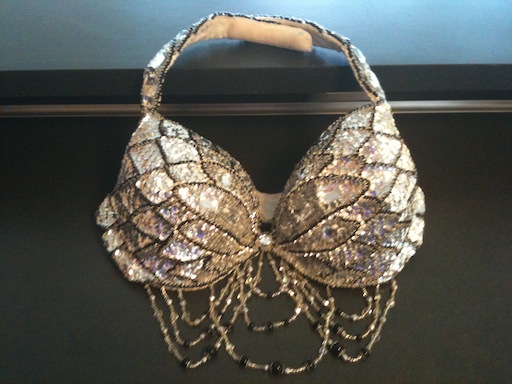

What we wear as costumes today are based on what we think we should wear. Whether we know it or not, that perspective is affected by everything from 1920's Hollywood silent films, to modern dancers in the Middle East, to what our friends like. And like all perspectives, it changes every day. There is no single authentic true bellydance costume. The trends of the 1980's were different than the 70's, 60's, 30's, and the 1800's. And the trends of tomorrow are no more or less "correct".
There is a really excellent book called Visions of the East; Orientalism in Film by Matthew Bernstein et al. It is a series of essays explaining basically how we got to where we are in our perception of Middle Eastern dance, beauty, and fantasy. It's important to understand where we've come from in order to sort out where you want to go. Without knowledge there is no free choice.
The "classic" image we have in our minds today can be traced back, at least in part, to the 1921 silent film entitled "The Skeik", starring Rudolf Valentino and Agnes Ayres. In the film, the female protagonist disguises herself as an Arabic Dancer so she can sneak into an Arab-only party. Her outfit was an invention of Hollywood, most likely heavily influenced by Flapper fashion (where we get all our beaded fringe) and Mata Hari - a Dutch exotic dancer born with the name Margaretha Geertruida Zelle. Flappers and Mata Hari were in turn influenced by many things, including the revolutionary politics of women taking control of their own sexuality, and the racist association that if civilization = the west = sexual oppression, then sexual freedom = the east = barbarianism. The word "exotic" was a loose reference to all strange or unknown cultures, and invoking it gave Western artists the freedom to do the avant guard and the taboo with impunity - the irony being that their ignorance of the real cultures was heralded as the peek of enlightenment. The fantasy was infectious, and novellas and films propagated it through a generation of Western women looking for an escape from adventure-less lives. Female Arabic dancers of the day didn't wear anything like Ayres' costume in "The Sheik", any more so than Arabic men wore Valentino's eye shadow. But the iconic image of the bare midriff dancer was born and has stuck with us in a variety of forms to this day. "The Sheik" and movies that copied it were watched around the world, including in the Middle East, and Middle Eastern night clubs dressed their performers in the way that would get the most attention and money from Western tourists.
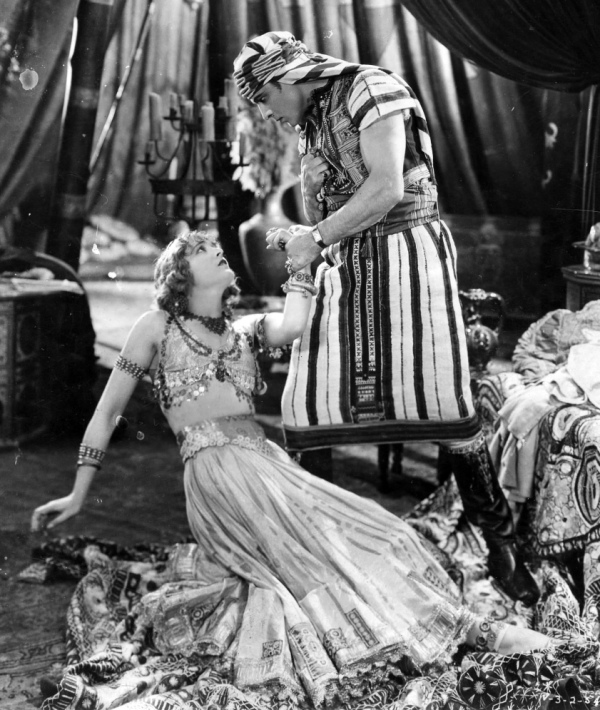
To see a more realistic image of what Middle Eastern dancers looked like before they were affected by Hollywood's makeover, take a look at some of the pictures from the Chicago World Fair of 1893. A 24 year old businessman named Sol Bloom brought dancers and musicians from all over the Middle East to make an exhibit. At first it didn't sell many tickets until a local minister heard that the women were not wearing corsets (this was in the Victorian era when corsets were socially mandatory for women). Once the pastor decried it from the pulpit as scandalous, there were lines around the block for people to see it. As a marketing ploy, Sol Bloom then called it "Belly Dance", and that name has stuck even though the movements are not limited to the abdomen. In a time when the word "leg" wasn't spoken in mixed company, and corseted women couldn't bend at the waist, the phrase Belly Dance was shocking and exciting - far moreso than "Folk Dances" ever could be. These were two Egyptian dancers, and the clothing of the one on the left may possibly indicate she is Ghawazee. Modern Ghawazee wear similar strips hung from the hips to accentuate twisting movements.
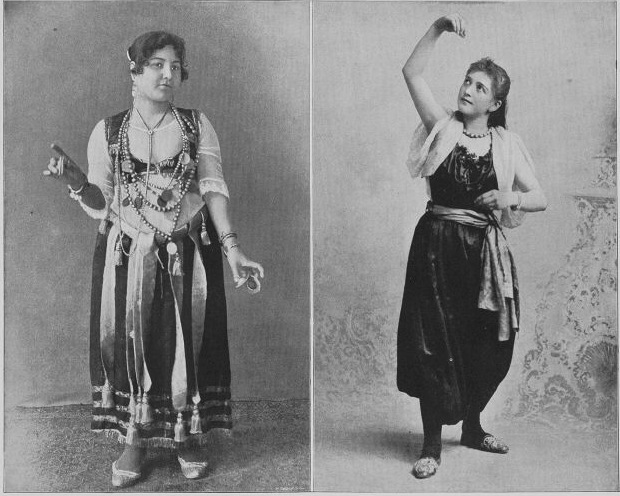
You may want your costume to emulate or exude a certain style, perhaps for it to be an homage to something that came before. Maybe you chose it simply because you think it's pretty. If you're trying to dress in a folkloric way, imitating a real group of people, it's important to do some basic research to learn about them first. For instance, Romani people do not touch clothing that is worn below the waist or wear the color red because it is taboo, so doing a "Romani styled" skirt dance with a flaming red skirt may not be the most accurate of performances, though Renn Faires might eat it up. Many Egyptian cabaret costumes of the 1980's and 90's had strange vertical attachments on the skirts to cover the belly buttons - because decency laws in Egypt made it at times illegal to show the belly button. These laws have changed over time and have made even certain dance movements, like a hip circle starting in the front, prohibited by law. The Middle East is made up of many different countries, ethnicities, cultures, languages, and religions. It's not just one group. The people of the Gulf dance differently than the Persians, who also dance differently than the Turks or the Lebanese. The Turkish Romani dance differently than the Turks. It isn't simple and the distinctions aren't cut and dry. But it is so worth it. Learning about the rich heritages and histories of the people will enrich your life and your dance.
You've made most of your design concept choices, but maybe you still need something to inspire you. I like to look at beautiful things in nature or works of art and make costumes based on them. The most obvious example might be my Silver Lotus costume, which is based on a flower called a Lotus blossom. Not only is it a pretty and distinctive shape, in Buddhist tradition the Lotus represents a harmonious union and balance of all of the elements, which is something I like to strive for in dance.
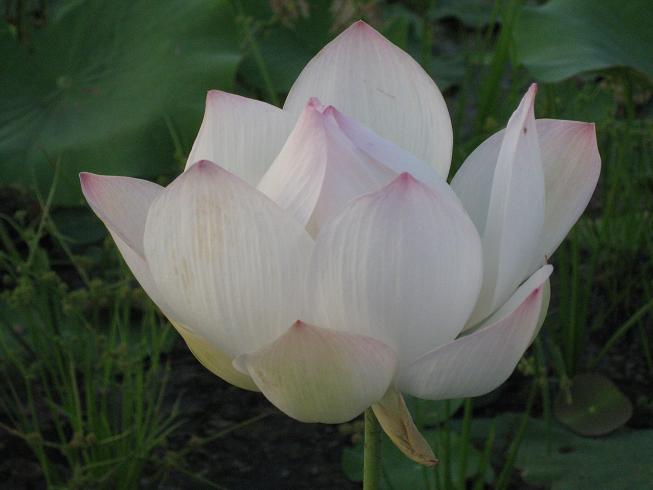
My Purple Velvet costume has ivy vines on it in Golden Ratio spirals. My Smoke Costume was inspired by the swirly, smokey fabric I found. My Gold Bedlah is designed to resemble filigree gold jewelry - where all the embellishments are contiguous, and the negative space is made out of fabric the color of my skin to create an illusion of being see-through.

Google image searches can be a gold mine for inspiration sources. But also, I like to search for things that have a cultural connection to the Middle East, such as Ottoman embroidery, the Iranian Crown Jewels (gorgeous!), henna patterns, and the beautifully intricate geometric shapes on Middle Eastern architexture and furniture.
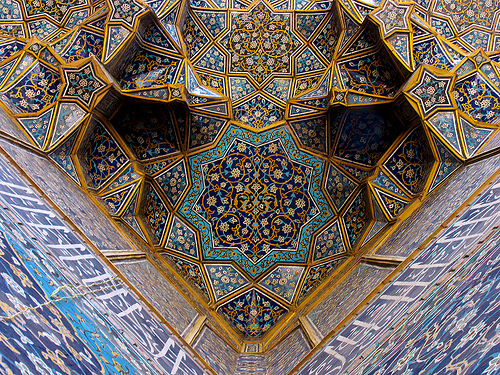
The more inspired you are, the more energy you'll be filled with as you make your costume. It won't feel like a chore to sew on all those hundreds of beads. Instead, each stitch will bring with it a feeling of excitement as your creation comes to fruition. I'm absolutely sure that if my brain chemistry were monitored while I created my costumes that every stitch would be accompanied by a tiny release of endorphins, just like when you hear a joke or see an adorable kitten. People are always amazed at the amount of energy I am able to put into making costumes, when the truth is that making costumes gives me energy.
Whether you're building an addition to your house or decorating a cake, it's important to think about where you want to end up before you start. Otherwise you end up covered in icing, which is delicious, but not the most productive use of time. I always draw sketches of my costume concepts, and often I go through several drafts before I'm happy with my design. Sometimes I even post the sketches on Facebook and ask my friends to help me decide between options. These were sketches for my Purple Velvet costume with silver vines.

Here's a preliminary sketch I had made of my Smoke Costume. I played with different ways of doing the back, and used scribbles to simulate beading. It's not always necessary to be very detailed in your sketches - even a scribble can help you determine if you like a concept or not.
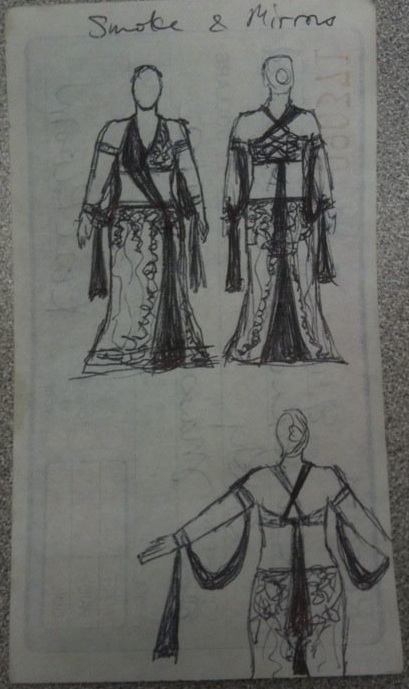
My final design will tend to resemble my final drawing, but there are always changes inspired by the Beading Doodle Pad or the making of the costume that will cause you to diverge from your plan. But without a plan to start from, you can feel lost and overwhelmed. If you're not much of an artist and feel intimidated with the idea of drawing yourself from scratch, I recommend taking a picture of yourself and using MS Paint, Photoshop, or even scissors or White Out to cut out whatever you're wearing, so you can draw on it. Here is a photo my husband took of me in my Burgundy Velvet costume - which I used Photoshop to cut off of me, and then drew on the printed picture with colored pencils and a black pen. I've never made this costume, but I liked the idea. The Costume Goddess would probably call this a diamond motif. Note the use of texture - the matte velvet trim on the top of the bra cups with square mirrors sewn on it versus a more metallic look on the rest of the cups made of dark grey sequins.
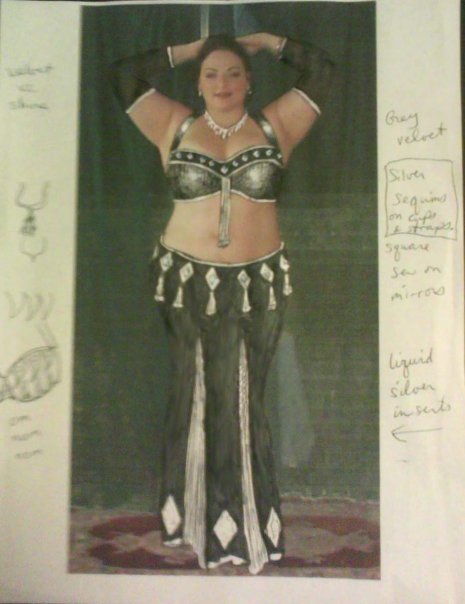
Also, once you've made the bases of your costumes (a covered bra, belt, or a skirt), you can draw on them with a shard of soap or a fabric pencil to see how you like your designs full scale before you commit to beading them out. Actually, I'll often draw my beading pattern on the interfacing of the belt in magic marker before I've covered it in fabric to see how I like it. This is especially useful if the outer edges of your belt are part of the shapes you will embellish - such as leaves or flower petals (look at the belt of the Silver Lotus bedlah). You could start with a ball point pen and then use magic marker on the lines you like best if you're nervous. The fabric will hide all the marks but as you're beading you can hold it up to the light to help yourself bead along the lines you drew.
